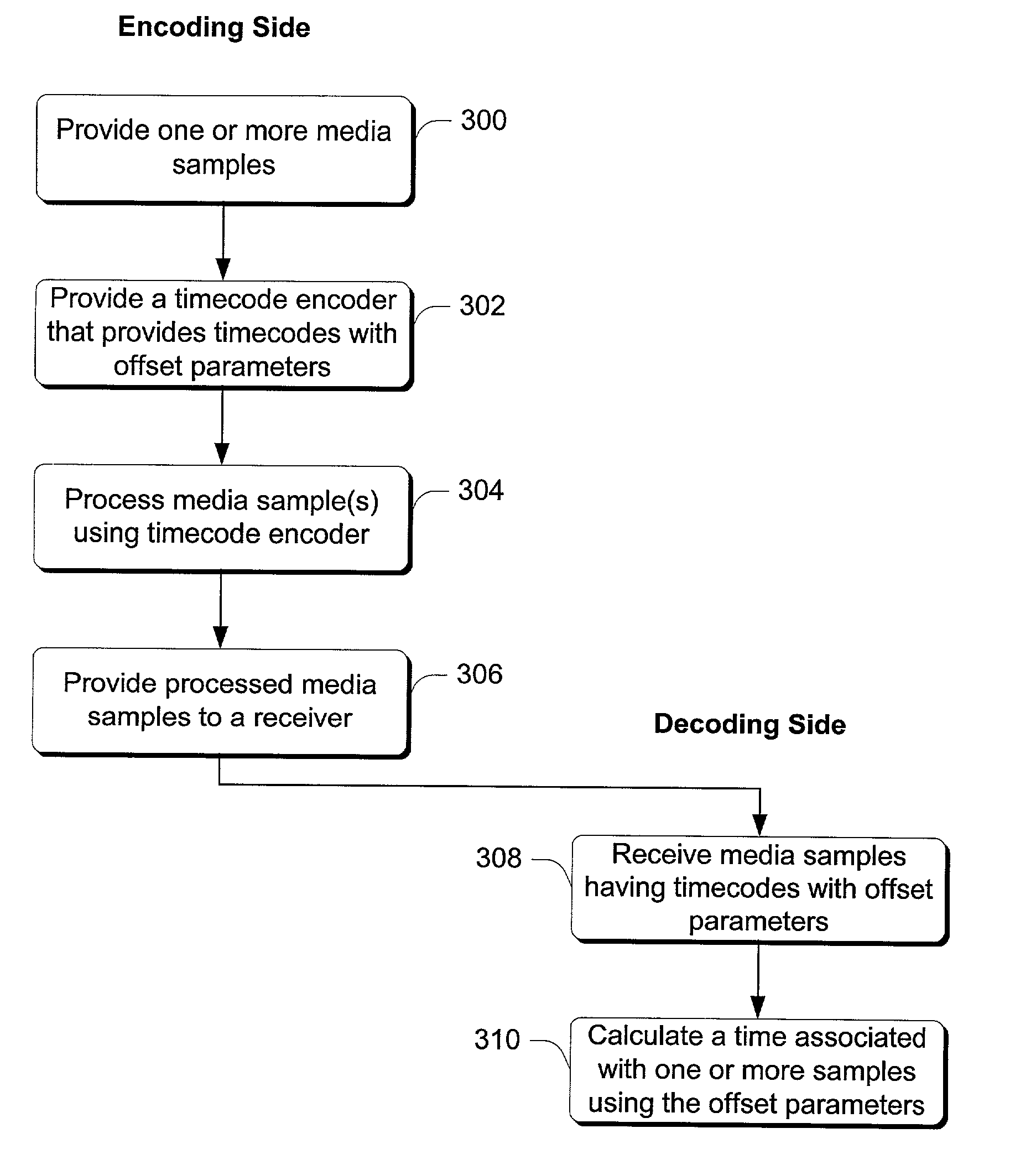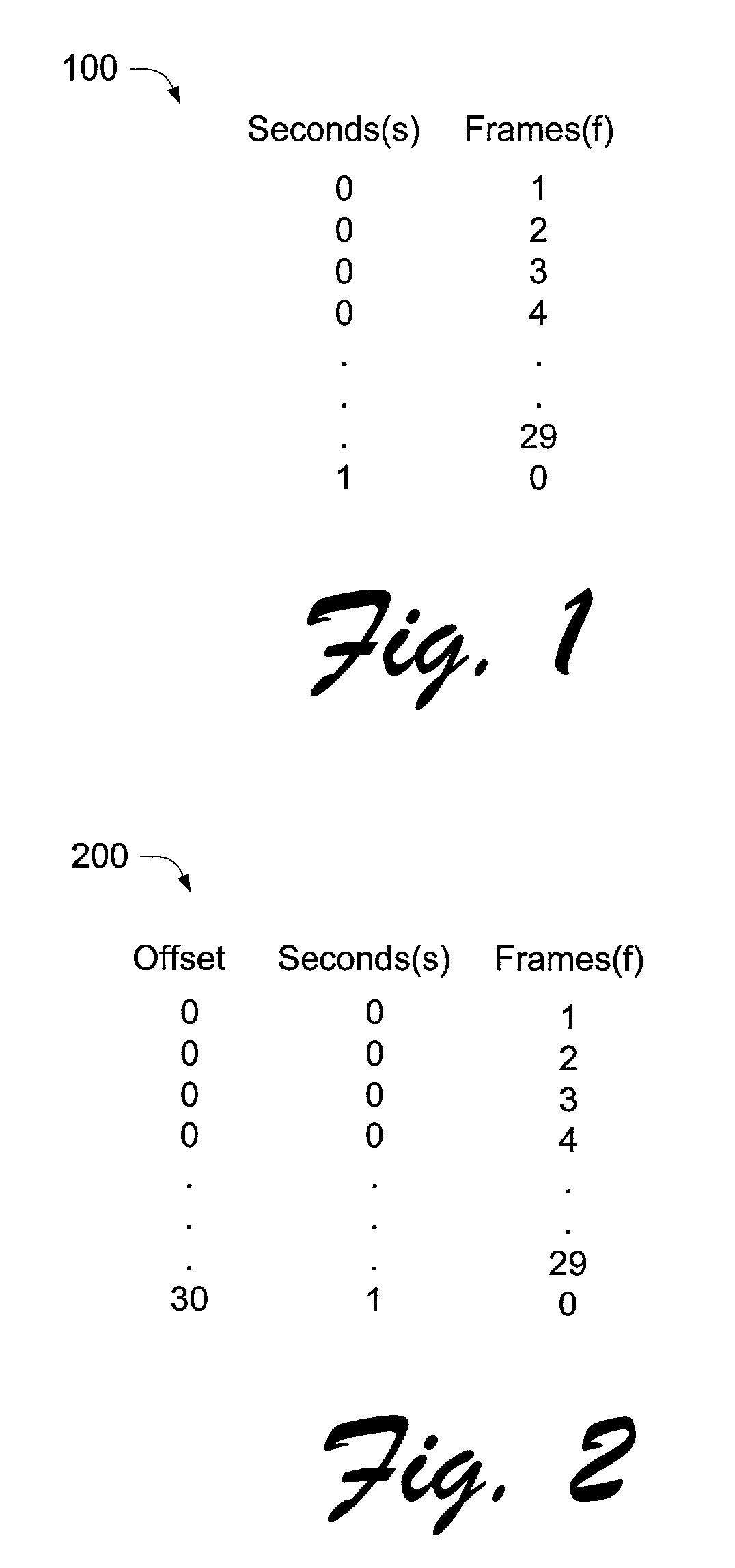Methods, systems and data structures for timecoding media samples
a media sample and timecoding technology, applied in the field of timecoding media samples, can solve problems such as difficulties in determining how to properly handle media samples in the system, frame not being received by the decoder, and certain amount of rounding errors, and achieve the effect of reducing dri
- Summary
- Abstract
- Description
- Claims
- Application Information
AI Technical Summary
Benefits of technology
Problems solved by technology
Method used
Image
Examples
example 1
[0101]The following example is given in the context of NTSC (approximately 29.97 frames per second) with SMPTE Non-drop Counting.
[0102]A SMPTE NTSC non-drop timecode can be represented in the timecode data structure fields of CountComp, Hours, Minutes, Seconds, and Frames without substantial alteration. The other parameters of the timecode should be specified as:[0103]MaxDays=1;[0104]CountComp=‘00’; (no counting compensation)[0105]BaseUPF=1001;[0106]BaseUPS=30000 (for frame-based timestamps), or 60000 (field-based);[0107]BaseFPF=1 (for frame-based timestamps), or 2 (field-based);[0108]Fields=0 (for frame-based timestamps), or 0 or 1 (field-based);
[0109]The Offset parameter should be set to the value of Drift as computed by the section entitled “Frame Rate Counting Compensation”. (Initially set to zero, then incremented by 30 (frame-based) or 60 (field-based) each time the value of Seconds increments.)
[0110]Note that the SMPTE timecode can then later be extracted directly from the Co...
example 2
[0135]The following example is given in the context of NTSC (approximately 29.97 frames per second) with SMPTE Drop Counting.
[0136]U.S. NTSC color video runs at approximately 29.97 frames / sec. If synchronized with program material at 30 frames / sec, there is an extra 0.03 frames every second, adding up to 3.6 seconds every hour or 108 extra frames. Drop Frame timecode was developed to reduce this drift that can cause synchronization problems. It does this by “dropping” certain specific timecodes in the sequence of timecodes. The adjustment method used in SMPTE Drop Frame timecode was to drop two timecode values each minute except for every tenth minute (minutes 00, 10, 20, 30, 40, 50). An example would be that 01:22:59:29 advances directly to 01:23:00:02, rather then first advancing to 01:23:00:00, then 01:23:00:01, and then 01:23:00:02. Codes 01:23:00:00 and 01:23:00:01 are dropped. This allows the timecode to run much closer to true time over significant periods.
[0137]A SMPTE NTSC ...
example 3
[0148]The following example is given in the context of PAL (50 fields per second) with SMPTE Timecode. A SMPTE PAL timecode can be represented in the timecode data structure fields of CountComp, Hours, Minutes, Seconds, and Frames without substantial alteration. The other parameters of the timecode should be specified as:[0149]MaxDays=1;[0150]CountComp=‘00’; (no counting compensation)[0151]BaseUPF=1;[0152]BaseUPS=25 (for frame-based timestamps), or 50 (field-based);[0153]BaseFPF=1 (for frame-based timestamps), or 2 (field-based);[0154]Fields=0 (for frame-based timestamps), or 0 or 1 (field-based);
[0155]The Offset parameter should then be set to the value of Drift as computed by the process described by the C++ code above (always zero in this case).
[0156]Note that the SMPTE timecode can then later be extracted directly from the CountComp, Hours, Minutes, Seconds, and Frames parameters, as its parameter values have been preserved without alteration.
PUM
 Login to View More
Login to View More Abstract
Description
Claims
Application Information
 Login to View More
Login to View More - R&D
- Intellectual Property
- Life Sciences
- Materials
- Tech Scout
- Unparalleled Data Quality
- Higher Quality Content
- 60% Fewer Hallucinations
Browse by: Latest US Patents, China's latest patents, Technical Efficacy Thesaurus, Application Domain, Technology Topic, Popular Technical Reports.
© 2025 PatSnap. All rights reserved.Legal|Privacy policy|Modern Slavery Act Transparency Statement|Sitemap|About US| Contact US: help@patsnap.com



